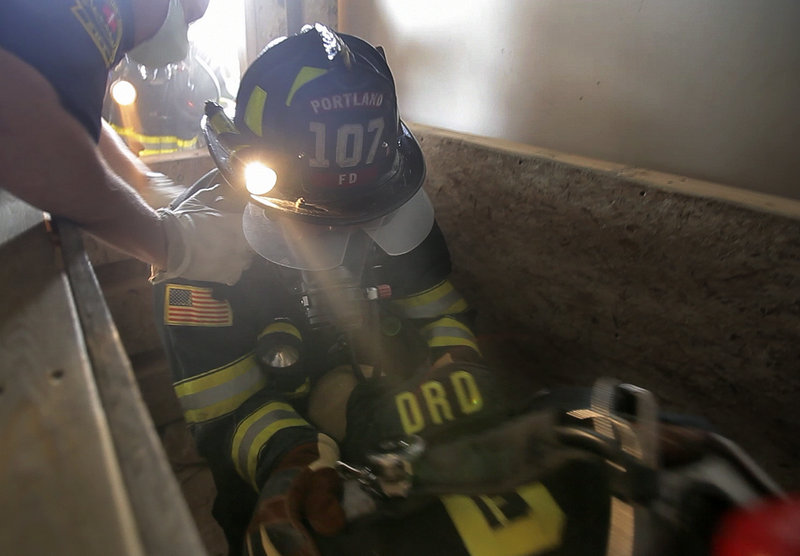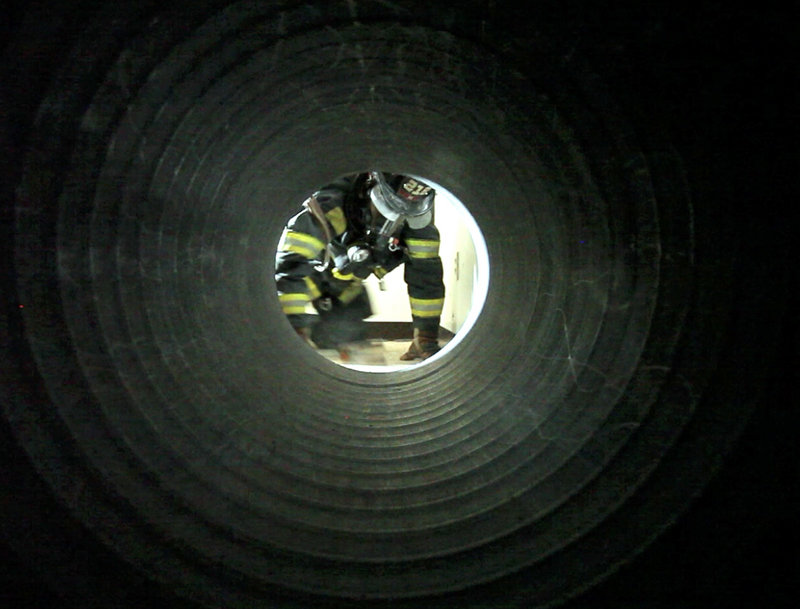PORTLAND – Firefighter Chris Thomson crawls on his knees, trailing one gloved hand along the wall, trying to keep his bearings as a black plastic film in his oxygen mask makes it almost impossible to see.
At one point during his simulated search for survivors, the floor drops out from under him and he falls about 3 feet. A bale of debris falls onto his back, pinning him, and showing him what he might experience if the floor collapses in a real building fire.
Thomson calls out “mayday” to rescuers, describing where he is as best he can, and triggers his personal alert safety system — a blinking red light and audio alarm.
It was all part of a very realistic fire department exercise held Wednesday at the vacant customs building at the International Marine Terminal on Commercial Street.
Most firefighters’ deaths happen when they become trapped or disoriented. Wednesday’s exercise was designed to create situations in which the firefighters must call for help.
Historically, firefighters have died waiting too long before calling for help, said Capt. Phil McGouldrick, who is in charge of the training.
“It’s a macho job. It reeks of testosterone,” he said, so firefighters can be slow to call for help.
Thomson, a 16-year veteran of the department, said a firefighter conducting a search calls out each door and window he can see as he passes it, to make mental notes of possible escape routes and to help pinpoint his location in an emergency.
The Portland Fire Department is having each of its fire companies go through tests and training as part of a safety awareness week.
“Firefighting is a very dangerous job,” said Fire Chief Fred LaMontagne. “I think that it is really important that we remain proficient in our skills.”
LaMontagne said the training emphasizes awareness of surroundings and potential hazards.
The training tests include negotiating an obstacle course, finding and retrieving a fallen firefighter in a smoke-filled room, and hoisting a hefty firefighter out of a narrow hallway through an elevated window.
In the obstacle course, firefighters climb under wires that can snag an air pack, squeeze through a 16-inch opening between wall joists — which requires them to take off the air pack — and climb through a narrow cylinder that could be a dead-end. A boom box plays a loud recording of a fire scene, with yelling and alarms, a disorienting cacophony.
As Thomson negotiates the course, he finds himself in a plywood box, like a closet where a child might hide from smoke and flames. A trap door shuts behind him, simulating a building collapse cutting of his retreat.
“What are you going to do to help them find you?” asks Capt. Keith Gautreau, who is shadowing Thomson through the course.
Later, the firefighters are pressed into service as a rapid intervention team. Lt. Rob Slaving lies on the floor, behind a couch. The team knows only that a firefighter is down. After Slaving lies still for about a minute, his personal alert safety system sounds, but it is muffled by cushions.
Firefighters climb a ladder to the second-floor mock apartment, reach through the window and probe the floor to make sure it can support their weight before they clamber inside.
The room is filled with almost impenetrable smoke from a smoke machine.
“You truly can’t see your hand in front of your face in a burning building,” McGouldrick said.
Firefighter James Westburg, his outline and bright yellow suspenders only occasionally visible through the smoke, describes the firefighters’ technique as they search the room.
At one point they agree to go silent, holding their breath to still the loud whoosh that comes from using an airpack. They can hear where Slaving’s alarm is coming from. At the back of the second room, they find Slaving, turn off his alarm and check to see that he is breathing.
They reattach the waistband of his airpack through his legs so they can drag him back to the window. After a minute or so of trying to find the best way to get the 200-pound firefighter and 60 pounds of gear through the window, they grab hold and heave him into the opening.
The drills help firefighters prepare for the unexpected, which could be the difference between life and death, McGouldrick said. “This is a situation where we need to be at the top of our game.”
Staff Writer Ellie Cole contributed to this article.
Staff Writer David Hench can be contacted at 791-6327 or at:
dhench@pressherald.com
Send questions/comments to the editors.




Success. Please wait for the page to reload. If the page does not reload within 5 seconds, please refresh the page.
Enter your email and password to access comments.
Hi, to comment on stories you must . This profile is in addition to your subscription and website login.
Already have a commenting profile? .
Invalid username/password.
Please check your email to confirm and complete your registration.
Only subscribers are eligible to post comments. Please subscribe or login first for digital access. Here’s why.
Use the form below to reset your password. When you've submitted your account email, we will send an email with a reset code.